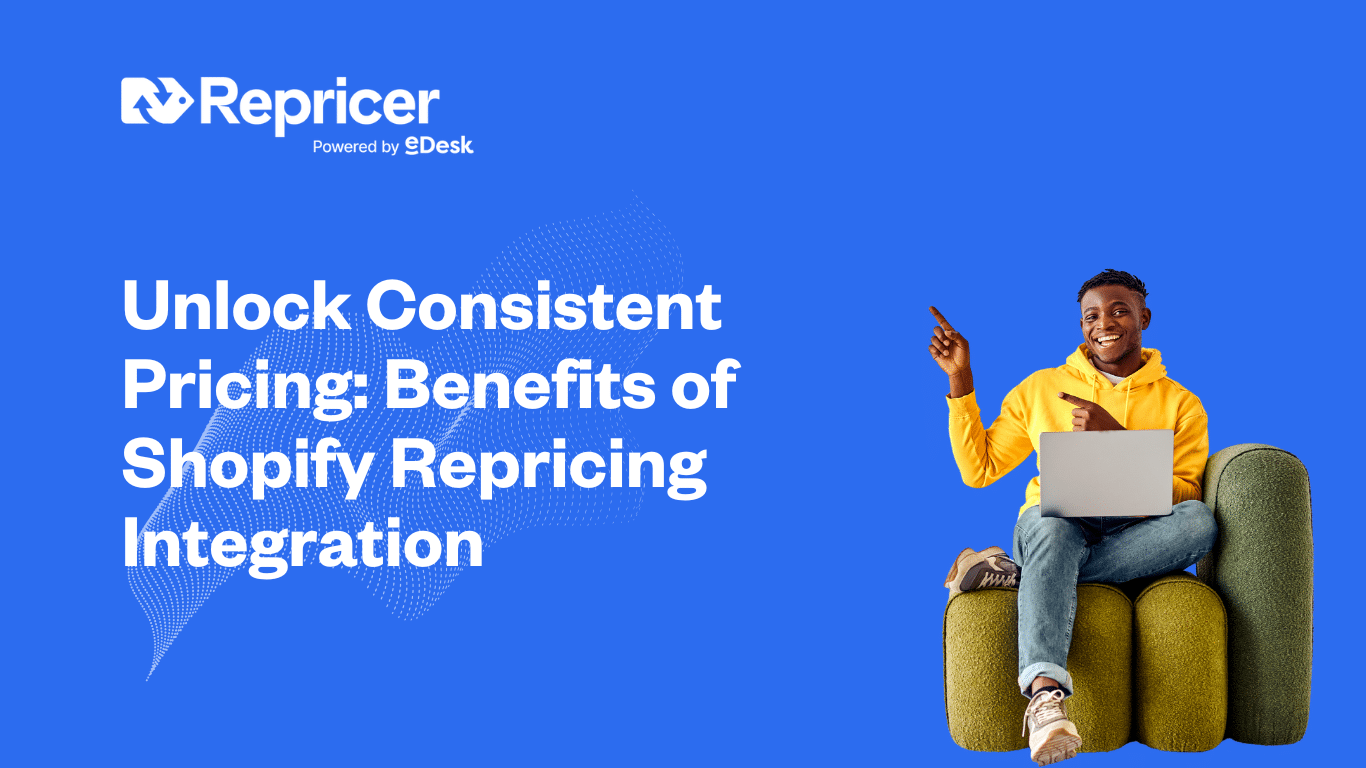Picture this: you’re running a successful Shopify store while selling the same products on Amazon, eBay, and Walmart. A competitor drops their prices on Amazon, and suddenly your products look overpriced everywhere. By the time you manually update prices across all channels, you’ve already lost sales. Sound familiar? This scenario plays out thousands of times daily for multichannel sellers, but there’s a smarter way forward.
The bottom line: Shopify repricing integration automates pricing consistency across all your sales channels, helping you stay competitive while protecting margins and saving countless hours of manual work.
Why Pricing Consistency Matters More Than Ever
The eCommerce landscape has exploded in complexity. As of 2025, there are 28 million eCommerce sites worldwide, marking a 2.9% increase from the previous year, and customers have become incredibly price-conscious. Between early and mid-2024, promotions and discounts were the top reasons people shopped online, influencing 53.6% of shoppers.
When you’re selling across multiple channels, maintaining consistent pricing isn’t just about convenience. It’s about building trust with customers who compare prices across platforms before buying. Other factors included price comparison tools and price match guarantees, which impacted 22% of shoppers.
Here’s what makes pricing consistency crucial for your business:
Customer Trust and Brand Integrity: When customers find different prices for the same product across your channels, it damages credibility. They start questioning which price is “real” and whether they’re getting a fair deal.
Competitive Positioning: Your pricing strategy affects how customers perceive your brand’s value proposition. Inconsistent pricing can position you as either too expensive or suspiciously cheap, depending on where customers encounter your products first.
Profit Protection: Without coordinated pricing, you might accidentally create race-to-the-bottom scenarios where your own channels compete against each other, eroding margins unnecessarily.
The Challenge of Multichannel Pricing for Shopify Merchants
Shopify store owners face unique challenges when expanding to marketplaces. A staggering 35% of Amazon merchants that utilize multichannel ecommerce as their storefront platform use Shopify, highlighting how common this challenge has become.
The traditional approach involves logging into each platform separately, checking competitor prices, and manually updating your listings. This process is time-consuming and error-prone, especially when you’re dealing with:
Dynamic Market Conditions: Prices change constantly based on demand, seasonality, competitor actions, and inventory levels. The concept of dynamic pricing has emerged as a powerful tool for businesses to stay agile and responsive to market conditions.
Inventory Synchronization: When stock levels change, pricing strategies often need adjustment to move inventory or protect margin on limited quantities.
Channel-Specific Requirements: Each marketplace has different fee structures, competition levels, and customer expectations that might justify different pricing approaches.
Scale Complexity: As your product catalog grows, manual price management becomes impossible to sustain effectively.
How Shopify Repricing Integration Transforms Your Business
A repricer for Shopify store operations changes everything by creating an omnichannel selling strategy that keeps all your channels synchronized and optimized. Here’s how the integration works:
Automated Price Synchronization
Instead of manually updating prices across platforms, repricing integration creates automated pricing workflows Shopify merchants can rely on. When you update a price in your Shopify admin, the system can automatically propagate that change to all connected marketplaces, or vice versa.
Real-Time Competitor Monitoring
The integration includes competitor monitoring Shopify capabilities that track pricing changes across marketplaces in real-time. When competitors adjust their prices, you’ll know immediately and can respond strategically rather than reactively.
Multichannel Pricing Optimization
Connect Shopify to Amazon repricer systems and other marketplace tools to create a unified pricing strategy. The system can analyze performance data from all channels to suggest optimal pricing that maximizes both sales volume and profit margins.
Shopify API Integration Benefits
Modern repricing tools leverage Shopify API integration to create seamless data flow between your store and external marketplaces. This means inventory levels, product information, and pricing data stay synchronized automatically, reducing errors and saving time.
Key Benefits of Implementing Shopify Repricing Integration
Time Savings and Operational Efficiency
72% of successful eCommerce companies are already using automation in some parts of their workflows, and pricing automation delivers some of the most immediate time savings. Instead of spending hours weekly on price updates, you can focus on strategic business growth.
The integration eliminates the manual task of checking competitor prices and updating your listings individually. This is particularly valuable as leading brands selling on three or more marketplaces experience a 104% growth in Gross Merchandise Value (GMV), demonstrating the effectiveness of a multichannel selling strategy.
Improved Competitive Positioning
The Shopify app dynamic pricing functionality helps you respond to market changes instantly. Whether a competitor launches a promotion or supply chain issues affect pricing industry-wide, your automated system can adjust prices within preset parameters to maintain competitiveness.
Enhanced Profit Margins
Rather than racing to the bottom on price, intelligent repricing helps optimize for profitability. The system can factor in your costs, desired margins, and market positioning to find the sweet spot between competitive pricing and healthy profits.
Scalability for Growth
As your business grows, manual pricing management becomes impossible. Repricing integration scales with your business, handling hundreds or thousands of products across multiple channels without additional manual effort.
Setting Up Your Shopify Repricing Integration
Choosing the Right Repricing Solution
When evaluating repricing tools, look for solutions that offer robust Shopify integration capabilities and support for all your target marketplaces. The best tools provide:
- Real-time price monitoring and updates
- Customizable pricing rules and strategies
- Comprehensive reporting and analytics
- Integration with multiple marketplaces beyond just Amazon
Integration Process and Best Practices
Most modern repricing solutions offer straightforward integration with Shopify through apps or API connections. The setup typically involves:
Initial Configuration: Connect your Shopify store and target marketplaces to the repricing platform.
Rule Setting: Define your pricing strategies, including minimum and maximum prices, target margins, and competitive positioning preferences.
Testing Phase: Start with a small subset of products to ensure the integration works correctly before scaling up.
Monitoring and Optimization: Regularly review performance data to refine your pricing strategies and rules.
Real-World Impact: What to Expect
Businesses implementing Shopify repricing integration typically see immediate operational improvements. The comprehensive features of modern repricing solutions enable merchants to:
- Reduce time spent on pricing tasks by 80-90%
- Improve price competitiveness across channels
- Maintain better profit margins through strategic pricing
- Scale multichannel operations more effectively
For merchants serious about multichannel pricing strategies, the integration becomes essential infrastructure rather than optional tooling.
Beyond Basic Repricing: Advanced Integration Benefits
Data-Driven Insights
Repricing integration provides valuable analytics about market trends, competitor behavior, and your pricing performance across channels. This data helps inform broader business strategies beyond just day-to-day pricing decisions.
Inventory Management Coordination
Advanced integrations can coordinate pricing with inventory levels. For example, as stock runs low, prices can automatically increase to slow sales and protect margin or decrease to clear inventory before it becomes obsolete.
Channel-Specific Optimization
Different marketplaces have different dynamics. Your repricing integration can optimize prices differently for Amazon versus eBay versus your Shopify store, accounting for varying fee structures, competition levels, and customer expectations.
Making the Strategic Decision
The choice isn’t really whether to implement repricing integration, but when and how. Companies with omnichannel customer engagement increase sales revenue growth by an average of 179% more than companies that do not implement similar strategies.
Consider your current situation: Are you spending significant time on manual price management? Are you losing sales to better-positioned competitors? Are you struggling to scale your multichannel operations effectively?
For most Shopify merchants selling across multiple channels, repricing integration pays for itself quickly through time savings alone, not to mention the revenue benefits of better pricing strategies.
Understanding the fundamental differences between selling strategies across platforms helps frame why automated coordination becomes essential as businesses grow.
Key Takeaways: Your Next Steps
Shopify repricing integration represents a critical infrastructure investment for multichannel sellers. The technology has matured to the point where it’s become essential rather than optional for competitive businesses.
Start with assessment: Evaluate how much time you currently spend on pricing tasks and calculate the opportunity cost of that time.
Research solutions: Look for repricing tools that offer robust Shopify integration and support for all your target marketplaces.
Plan implementation: Start with a subset of products to test and optimize your approach before scaling up.
Monitor results: Track both operational metrics (time saved) and business metrics (sales, margins) to measure success.
The eCommerce landscape will only become more competitive and complex. Global eCommerce revenue is projected to exceed $6.4 trillion by 2029, with an annual growth rate (CAGR) of 9.49% from 2024 to 2029. Merchants who automate pricing consistency and optimization now will be better positioned to capitalize on this growth.
Ready to streamline your multichannel pricing strategy? The integration tools exist today to transform how you compete across channels. The question is whether you’ll implement them before or after your competitors gain the advantage.





